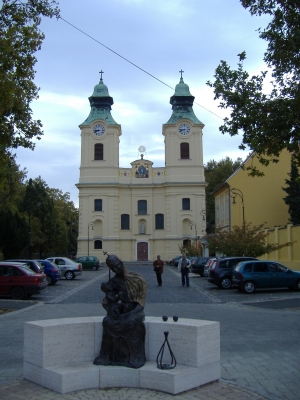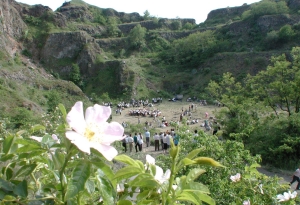Celldömölk, the centre of Kemenesalja, prides with a history of over 750 years. The first written record dates back to 1252, though the exact date of the town's foundation is not yet known. There used to be two settlements here in the mid-13th century: Pórdömölk served as the village of peasants and servants, while Nemesdömölk was inhabited by noblemen. 
A Benedictian abbey was set up here during the 13th century, and by the 16th century Celldömölk had become a well-known scene for fairs. The so-called 'Miracle-making sculpture' was escaped from the settlement during the Turkish attacks. After this time the religious life prospered thanks to the abbot, Odó Koptik, who brought the copy of the sculpture from Mariazell, the Austrian village nearby. The pilgrim-church, which was also designed on the basis of the one in Mariazell, was dedicated in 1755. In the same year the Calvary was built, which finally made Celldömölk a worthy site of fétes.
Tradesmen and merchants helped increase the number of inhabitants from the end of the 18th century onwards making it the centre of the region together with its famous fairs and stores of salt.
The Casino of Kemenesalja got built in 1830, and Celldömölk became the seat of the district from the middle of the 19th century. This was the time that the railway reached the area, thus by the turn of the century Kiscell had become a railway junction for both passengers and goods. Little wonder that the decades coming saw a dramatic increase in the number of inhabitants.
The two small settlements, Kiscell and Nemesdömölk were joined in 1904 and named Celldömölk. Alsóság in 1950, and Izsákfa in 1978 also joined, so Celldömölk was awarded with the rank of a town on 6 January 1978 becoming the centre of Kemenesalja with its population of 12,000.
The botanic and lawyer, Gyula Gayer, was born here in 1883. He carried out remarkable research on the flora of Ság hill. Today two primary schools remind us of him. Ferenc Kresznerics, catholic dean and teacher was the first person from the countryside to be honoured with the membership of the Hungarian Academy. His tomb can be seen in the cemetery of Alsóság, and the library of Celldömölk bears his name.
Approaching to the western boundery of Celldömölk one can admire the remains of 12th century abbey.
The Church of the Blessed Virgin Mary, built in 1747-48, is of special significance, where the abbot, Odó Koptik had a separate chapel built for the 'Miracle-making Sculpture'. Above the sacristy a treasury was set up.
Right next to the church you will find the building of the Benedictian abbey, which at he moment functions as the Mayor's Office. Behind the church the Calvary built in 1755, in the church square the Statue of Holy Trinity finally completed in 1836 can be seen.
Remarkable events of Celldömölk include:
- the féte of 12 September linked to the nameday of Mary
- Vintage Days of Ság hill every autumn
- Crater-concert of Ság hill
- Theatre Festival organized by the Lajos Solti Theatre
- Arts Festival of Kemenesalja
- Festival of Choirs of music schools
- International Volcano-football Festival
- Spring Festival of Alsóság
- Village Day of Izsák.
Ság hill: The ruby of Kemenesalja is nearly 5 million years old. This is a 279-metre-basalt volcano, most of which has become a district of landscape conservation.
It is mining that has made Ság hill really valuable, due to which one has the possibility of having a close look at the inner part of the hill, including its remarkable geological history.
Not only the ornitological and geological routes but also the Museum of Ság hill familiarises the visitor with the natural, historic and cultural values of this region.
The Trianon Cross towers over the hill. It was erected in 1934 financed by the local population's charity, in memory of the peace treaties of 1920.
In 1891 Lóránd Eötvös carried out geodesic research here with the pendulum, later named after him. There is still a memorial column there, reminding us of the importance of his work.
Ság hill belongs to the Historic Wine-region of Somló, where winegrowing has been playing a crucial role in the people's life here for ages. According to records the wine from Ság hill was specially enjoyed by the chancellor, Otto von Bismarck, who would say, 'The wine from Ság hill is healing!'


